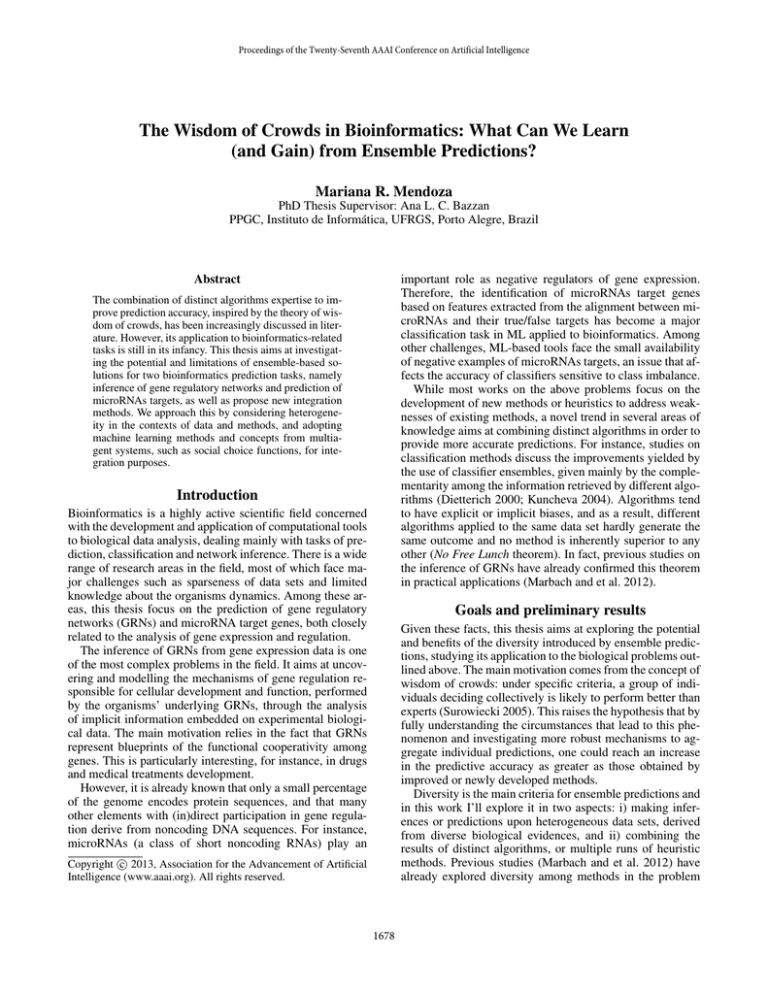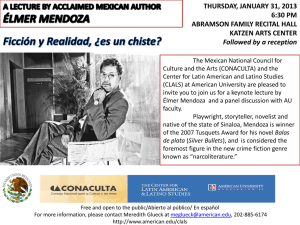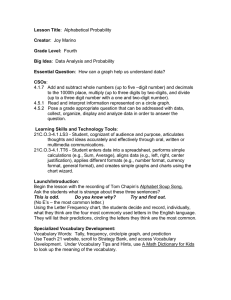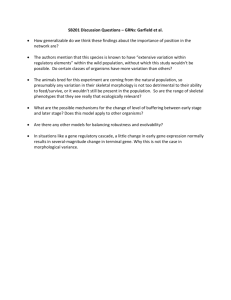
Proceedings of the Twenty-Seventh AAAI Conference on Artificial Intelligence
The Wisdom of Crowds in Bioinformatics: What Can We Learn
(and Gain) from Ensemble Predictions?
Mariana R. Mendoza
PhD Thesis Supervisor: Ana L. C. Bazzan
PPGC, Instituto de Informática, UFRGS, Porto Alegre, Brazil
Abstract
important role as negative regulators of gene expression.
Therefore, the identification of microRNAs target genes
based on features extracted from the alignment between microRNAs and their true/false targets has become a major
classification task in ML applied to bioinformatics. Among
other challenges, ML-based tools face the small availability
of negative examples of microRNAs targets, an issue that affects the accuracy of classifiers sensitive to class imbalance.
While most works on the above problems focus on the
development of new methods or heuristics to address weaknesses of existing methods, a novel trend in several areas of
knowledge aims at combining distinct algorithms in order to
provide more accurate predictions. For instance, studies on
classification methods discuss the improvements yielded by
the use of classifier ensembles, given mainly by the complementarity among the information retrieved by different algorithms (Dietterich 2000; Kuncheva 2004). Algorithms tend
to have explicit or implicit biases, and as a result, different
algorithms applied to the same data set hardly generate the
same outcome and no method is inherently superior to any
other (No Free Lunch theorem). In fact, previous studies on
the inference of GRNs have already confirmed this theorem
in practical applications (Marbach and et al. 2012).
The combination of distinct algorithms expertise to improve prediction accuracy, inspired by the theory of wisdom of crowds, has been increasingly discussed in literature. However, its application to bioinformatics-related
tasks is still in its infancy. This thesis aims at investigating the potential and limitations of ensemble-based solutions for two bioinformatics prediction tasks, namely
inference of gene regulatory networks and prediction of
microRNAs targets, as well as propose new integration
methods. We approach this by considering heterogeneity in the contexts of data and methods, and adopting
machine learning methods and concepts from multiagent systems, such as social choice functions, for integration purposes.
Introduction
Bioinformatics is a highly active scientific field concerned
with the development and application of computational tools
to biological data analysis, dealing mainly with tasks of prediction, classification and network inference. There is a wide
range of research areas in the field, most of which face major challenges such as sparseness of data sets and limited
knowledge about the organisms dynamics. Among these areas, this thesis focus on the prediction of gene regulatory
networks (GRNs) and microRNA target genes, both closely
related to the analysis of gene expression and regulation.
The inference of GRNs from gene expression data is one
of the most complex problems in the field. It aims at uncovering and modelling the mechanisms of gene regulation responsible for cellular development and function, performed
by the organisms’ underlying GRNs, through the analysis
of implicit information embedded on experimental biological data. The main motivation relies in the fact that GRNs
represent blueprints of the functional cooperativity among
genes. This is particularly interesting, for instance, in drugs
and medical treatments development.
However, it is already known that only a small percentage
of the genome encodes protein sequences, and that many
other elements with (in)direct participation in gene regulation derive from noncoding DNA sequences. For instance,
microRNAs (a class of short noncoding RNAs) play an
Goals and preliminary results
Given these facts, this thesis aims at exploring the potential
and benefits of the diversity introduced by ensemble predictions, studying its application to the biological problems outlined above. The main motivation comes from the concept of
wisdom of crowds: under specific criteria, a group of individuals deciding collectively is likely to perform better than
experts (Surowiecki 2005). This raises the hypothesis that by
fully understanding the circumstances that lead to this phenomenon and investigating more robust mechanisms to aggregate individual predictions, one could reach an increase
in the predictive accuracy as greater as those obtained by
improved or newly developed methods.
Diversity is the main criteria for ensemble predictions and
in this work I’ll explore it in two aspects: i) making inferences or predictions upon heterogeneous data sets, derived
from diverse biological evidences, and ii) combining the
results of distinct algorithms, or multiple runs of heuristic
methods. Previous studies (Marbach and et al. 2012) have
already explored diversity among methods in the problem
c 2013, Association for the Advancement of Artificial
Copyright Intelligence (www.aaai.org). All rights reserved.
1678
(mimicking different expertise) to learn a model independently, upon different features (point of view), and then work
towards building a consensus domain for the classification
task by means of social choice functions (SCFs). Thus, this
work also aims at devising a solution for distributed classification tasks. Based on a multi-fold evolution, I found that
the combination of predictions by SCFs has improved classification results in contrast to individual classifiers, increasing accuracy and yielding more consistent predictions across
multiple runs.
of predicting GRNs, showing that this is indeed a promising
approach. Thus, here I intend to go beyond the aggregation
mechanisms used in past studies and import ML methods,
as well as concepts from multiagent systems, such as social
choice functions, as different and more sophisticated ways
of combining classifier decisions. My goal is to seek further insight into the potential, robustness and limitation of
ensemble-based approaches, applying it to optimise performance in the selected bioinformatics problems. Nonetheless,
I hope the solutions and knowledge drawn in this work concerning ensemble predictions will be broadly applicable in
other domains.
As part of my thesis, I’ve developed a genetic algorithm (GA) solution for the inference of GRNs modelled
as Boolean networks. I explored different fitness functions,
representations and heuristics for genetic operators (Mendoza and Bazzan 2011; Mendoza, Lopes, and Bazzan 2012),
as well as proposed a new mutation operator based on the
epsilon-greedy strategy to exploit available prior knowledge
(Mendoza, Werhli, and Bazzan 2012). Moreover, while most
GA solutions adopt a criterion to select one of the individuals in the last generation as the final network, in these works
the concept of wisdom of crowds is applied to build a consensus network given a set of highly scored individuals in
the final GA population. Results show that the area under
the ROC curve (AUROC) for the final consensus network is
higher than the average AUROC score for individual predictions in every case tested, even with simple voting mechanisms, such that results could be even better if more robust
integration methods were considered.
Moreover, I performed a comparative study among popular fusion-based combination methods in classifier ensembles, considering the prediction of GRNs upon different algorithms (Mendoza and Bazzan 2012) in order to investigate ensemble effects in this specific problem. Results confirm the hypothesis that even simple and linear combination
methods, such as the average of confidence levels given by
inference methods to gene interactions, outperform the individual solutions. More sophisticated combination methods,
such as voting by Borda count and the statististical method
Dempster-Shafer, provide outstanding performance gain.
In what concerns the problem of predicting microRNAs
target genes, I’ve worked in collaboration with biologists to
develop a tool for the prediction of human microRNAs targets based on the Random Forest algorithm (Mendoza et al.
2012), which is by itself an ensemble approach based on the
aggregation of several predictions provided by a set of decision trees. The collection of features based on which our tool
performs classification, combined to the robustness of Random Forest, has yielded a superior predictive accuracy when
compared to other widely used classification algorithms.
More recent work consists in the development of a multiagent classification system to cope with classification tasks
characterised by diverse methods and vertical data distribution, testing it with the prediction of human microRNAs
targets. Multiagent systems (MAS) are a natural choice for
such scenario as they are able to deal with distributed data
and expertise, as well as heterogeneous information. In the
proposed framework, agents encapsulate distinct classifiers
Future work
The next steps of my work, to be accomplished until August
2013, concern a deeper investigation about SCFs, as well as
the development of new combination methods and criteria,
seeking inspiration in ML and MAS negotiation methods.
Ideally, both data and algorithms diversity will be explored
and compared for the two problems outlined in this summary. Experiments will be designed to help in better understanding the power and limitation of ensemble predictions,
their potential to overcome intrinsic bias, the impact of properties such as homogeneity and heterogeneity of the group,
as well as their robustness to weak classifiers or noisy data.
Final goals of this thesis include the development of a framework that automates the generation of consensus predictions
based on the principle of wisdom of crowds, yielding more
accurate and interpretable (in a biological sense) results.
References
Dietterich, T. 2000. Ensemble Methods in Machine Learning.
In Multiple Classifier Systems. Springer. 1–15.
Kuncheva, L. I. 2004. Combining Pattern Classifiers: Methods
and Algorithms. Wiley-Interscience.
Marbach, D., and et al. 2012. Wisdom of crowds for robust
gene network inference. Nature Methods 9(8):796–804.
Mendoza, M. R., and Bazzan, A. L. C. 2011. Evolving Random Boolean Networks with Genetic Algorithms for Regulatory Networks Reconstruction. In Proceedings of GECCO
2011, 291–298. New York, NY, USA: ACM.
Mendoza, M. R., and Bazzan, A. L. C. 2012. On the Ensemble
Prediction of Gene Regulatory Networks: a Comparative Study.
In Proceedings of SBRN 2012, 55–60. IEEE Computer Society.
Mendoza, M. R., and et al. 2012. RFMirTarget: a Random
Forest Classifier for Human miRNA Target Gene Prediction.
In Proceedings of BSB 2012, number 7409 in Lecture Notes in
Bioinformatics, 97. Berlin Heidelberg: Springer.
Mendoza, M. R.; Lopes, F. M.; and Bazzan, A. L. C. 2012. Reverse Engineering of GRNs: an Evolutionary Approach based
on the Tsallis Entropy. In Proceedings of GECCO 2012, 185–
192. New York, NY, USA: ACM.
Mendoza, M. R.; Werhli, A. V.; and Bazzan, A. L. C. 2012.
An Epsilon-Greedy Mutation Operator Based on Prior Knowledge for GA Convergence and Accuracy Improvement: an Application to Networks Inference. In Proceedings of SBRN 2012,
67–72. IEEE Computer Society.
Surowiecki, J. 2005. The Wisdom of Crowds. New York, NY:
Random House.
1679








